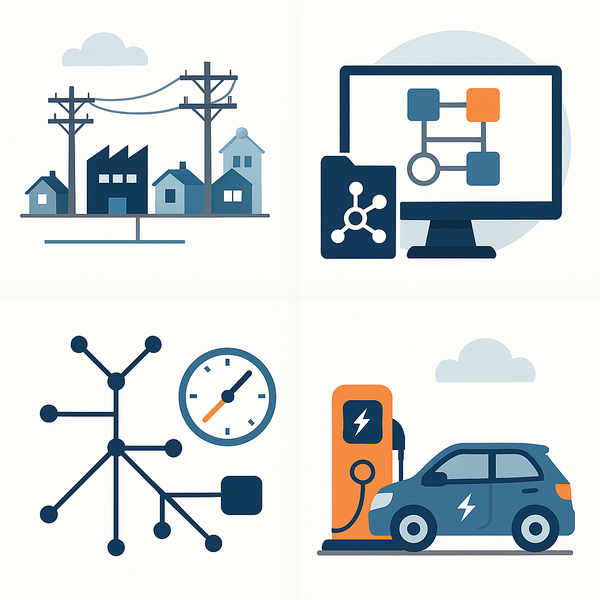Overview of Research Themes

In distribution system management, enhancing system observability is a prerequisite for optimal voltage and power flow control. Our laboratory has systematically developed fundamental data-driven techniques, including automatic estimation of line impedances in low-voltage distribution networks, completion of missing smart meter data, topology estimation, and fast approximation of power flows using machine learning. These techniques provide the foundation for reconstructing the state of distribution networks from incomplete and uncertain field data, enabling coordinated control for voltage regulation and loss reduction.
More specifically, we have proposed methods and devices (including related patents) for automatic estimation of line impedance in low-voltage distribution networks, and extended them to coordinated voltage control that combines reactive power control of distributed energy resources such as photovoltaic systems, battery energy storage systems, and electric vehicles (EVs). We have also developed topology-consistent estimation methods to reconstruct missing smart meter readings using network structure and physical constraints, thereby improving the overall data quality of the distribution network. In addition, by developing enhanced particle-swarm-optimization-based estimation algorithms and adaptive power-flow forecasting models with machine learning, we achieve both speed and accuracy required for online operation.
Building on these foundations, our recent work assumes massive integration of small-scale resources such as EVs and residential batteries, and advances toward “operation-oriented” research that tightly integrates data accuracy and optimal control of devices. High-quality data obtained through observation and estimation (impedance, topology, missing data completion, and power flow approximation) are directly linked to control policies for balancing supply and demand and maintaining voltage levels, aiming at an operational design that simultaneously satisfies stability, economic efficiency, and scalability at the distribution-system level.
- 1. Missing data completion: Maintaining observability while tolerating missing and erroneous measurements from smart meters and photovoltaic systems.
- 2. System parameter estimation: Automatically estimating line impedances in low-voltage networks to improve the accuracy of voltage control and loss evaluation.
- 3. Computational acceleration: Approximating power flow calculations with machine learning models to enable fast prediction and assessment for online operation.
- 4. EV–charger pairing: Identifying which EV is connected to which normal (AC) charger to provide reliable charging services to users.
Collaborative Projects and Partners
- Collaborative research with the Institute of Industrial Science, The University of Tokyo (2024–present) : We collect data from real EVs and normal chargers, and develop cloud-based algorithms for EV–charger pairing.
Individual Research Topics
Topics on Missing Data Completion
- Missing data completion for training datasets in photovoltaic power output forecasting [Slides]
- Improving forecast reliability for geographically distributed photovoltaic systems [Slides]
Topics on EV–Charger Pairing
- Identification of individual EVs and normal chargers using modulated charging current [Slides]
Related Publications
- J. Park, D. Kodaira, K. A. Agyeman, T. Jyung, and S. Han, “Adaptive Power Flow Prediction Based on Machine Learning,” Energies, vol. 14, 3842, 2021.
- D. Kodaira, J. Park, S. Y. Kim, S. Han, and S. Han, “Impedance estimation with an enhanced particle swarm optimization for low-voltage distribution networks,” Energies, vol. 12, no. 6, 1167, 2019.
- D. Kodaira and S. Han, “Topology-based estimation of missing smart meter readings,” Energies, vol. 11, no. 1, 224, 2018.
- D. Kodaira and S. Han, “A model based estimation for smart meter missing readings,” in IEEE PES General Meeting, 2017, pp. 1–5.
- S. Han, D. Kodaira*, S. Han, B. Kwon, Y. Hasegawa, and H. Aki, “An Automated Impedance Estimation Method in Low-Voltage Distribution Network for Coordinated Voltage Regulation,” IEEE Transactions on Smart Grid, vol. 7, no. 2, pp. 1012–1020, 2016. (*Corresponding author)
Related Patents
- H. Aki, Y. Hasegawa, S. Han, and D. Kodaira, “Impedance estimation device and estimation method for power distribution line,” US Patent 10,365,310, 2019.
External Grants
Currently, there are no external grants directly related to this research theme.
Internal Grants
Currently, there are no internal grants directly related to this research theme.
研究テーマの概要

配電系統マネージメントでは、まず系統の「見える化(Observability)」を高めることが、最適な電圧制御・潮流制御の前提になります。当研究室はこれまで、低圧配電網における線路インピーダンスの自動推定、スマートメーター欠測の補完、トポロジー推定、そして機械学習による潮流の高速近似など、観測データを起点とした基盤技術を系統的に整備してきました。これらは、現場で収集される不完全・不確実なデータからでも、配電網の状態を再構築し、電圧維持やロス低減のための協調制御を可能にするための土台です。
具体的には、低圧配電網の線路インピーダンスを自動推定する手法とデバイス(関連特許を含む)を提案し、分散電源(太陽光発電・蓄電池・電気自動車(EV))の無効電力制御と組み合わせた協調電圧制御に展開してきました。また、スマートメーターの欠測値を、ネットワーク構造や物理制約を用いてトポロジー整合的に復元する推定法を開発し、配電網全体のデータ正確性を高めています。さらに、粒子群最適化(Particle Swarm Optimization)を改良した推定アルゴリズムや、機械学習による適応的な潮流予測モデルを構築することで、オンライン運用に必要なスピードと精度の両立を実現しています。
これらの基盤の上で、近年はEVや家庭用蓄電池などの小規模リソースが大量導入される前提で、制御対象のデータの正確性と機器の最適制御を一体化した「運用ベース」の研究へと発展させています。観測・推定(インピーダンス/トポロジー/欠測補完/潮流近似)で得た高品質データを、需給調整や電圧維持の制御則に直結させ、配電網レベルでの安定性・経済性・拡張性を同時に満たす運用設計を目指します。
- 1. 欠損値補完:スマーメーターや太陽光発電の計測の抜けや誤りを許容しつつ観測性を確保
- 2. 系統パラメータの推定:低圧系統の線路インピーダンスを自動推定し、電圧制御・損失評価の精度を向上
- 3. 計算高速化:機械学習モデルによる潮流計算の近似で、高速なオンライン運用に耐える予測・評価を実現
- 4. EV-充電器ペアリング:ユーザーへの充電サービスを実現するため、普通充電器と接続しているEVのペアリング技術
連携プロジェクト・企業
- 東京大学生産研との共同研究(2024–現在): 普通充電器とEVの実機からデータを収集し、クラウド上のデータでペアリングを行う技術の開発
個別の研究テーマ
欠損値補完に関するテーマ
EV-充電器ペアリングに関するテーマ
- 変調充電電流を用いた電気自動車と普通充電器の個体識別手法の開発 [発表スライド]
関連出版物
- J. Park, D. Kodaira, K. A. Agyeman, T. Jyung, and S. Han, “Adaptive Power Flow Prediction Based on Machine Learning,” Energies, vol. 14, 3842, 2021.
- D. Kodaira, J. Park, S. Y. Kim, S. Han, and S. Han, “Impedance estimation with an enhanced particle swarm optimization for low-voltage distribution networks,” Energies, vol. 12, no. 6, 1167, 2019.
- D. Kodaira and S. Han, “Topology-based estimation of missing smart meter readings,” Energies, vol. 11, no. 1, 224, 2018.
- D. Kodaira and S. Han, “A model based estimation for smart meter missing readings,” in IEEE PES General Meeting, 2017, pp. 1–5.
- S. Han, D. Kodaira*, S. Han, B. Kwon, Y. Hasegawa, and H. Aki, “An Automated Impedance Estimation Method in Low-Voltage Distribution Network for Coordinated Voltage Regulation,” IEEE Transactions on Smart Grid, vol. 7, no. 2, pp. 1012–1020, 2016. (*Corresponding author)
関連特許
- H. Aki, Y. Hasegawa, S. Han, and D. Kodaira, “Impedance estimation device and estimation method for power distribution line,” US Patent 10,365,310, 2019.
助成金(学外)
現在、本テーマに関連する学外助成金はありません。
助成金(学内)
現在、本テーマに関連する学内助成金はありません。